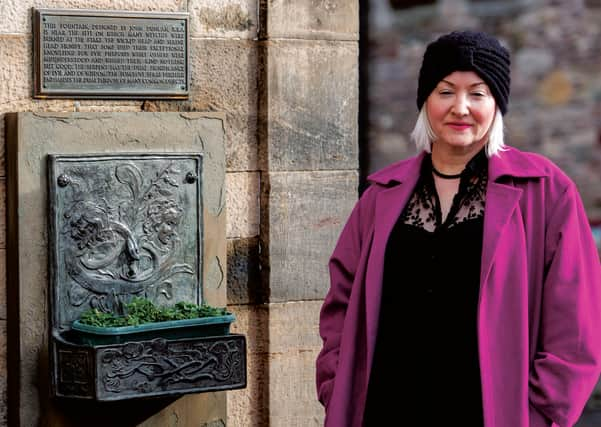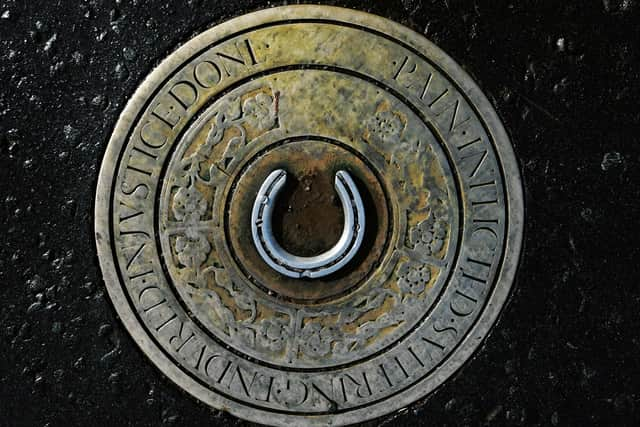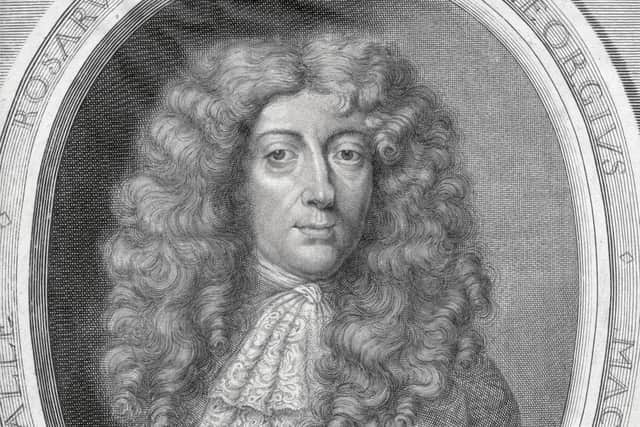Accused, tortured, strangled, burned: Why Scotland’s witches should be pardoned


Claire Mitchell – a QC and devotee of Siouxsie and the Banshees – is wearing black lace and a sparkling black Swarovski ring and talking about witches. An advocate who spends her days fighting to overturn alleged miscarriages of justice, she has turned her attention to one of the greatest formally unacknowledged wrongs in Scottish legal history: the persecution of 4,000 people, the vast majority of them women, for supposed sorcery.
Around 2,500 people are thought to have been executed – strangled at the stake and then burned between the 16th and 18th centuries. Yet, there is nothing on the statute books or in our public spaces to mark this atrocity. There has been no public apology; and no national monument to their fate.
Advertisement
Hide AdAdvertisement
Hide AdThe Covenanters who were locked up and tortured by the brutal Lord Advocate, George “Bluidy” Mackenzie are remembered on both a plaque and the Martyrs Memorial in Greyfriars Kirkyard, where they were imprisoned. But there is no similar commemoration of the malfeasance perpetrated against these women. The best Edinburgh has to offer is the Witches’ Well, a cast-iron drinking fountain on the eastern end of the Castle Esplanade, which, with its serpent’s head and evil eye, continues to hint at shapeshifting. Worse is to be found in Paisley. There, a circular bronze plaque marking the spot in which the ashes of seven witches were buried is adorned with a horseshoe: an amulet to protect the town from their enduring wickedness.


Mitchell wants an end to this inequity. She has chosen today – International Women’s Day – to launch a campaign to secure a pardon for all those convicted of witchcraft, and an apology for those who were accused and then acquitted. The plan is to marshal public support and present a petition to Holyrood.
Though the time that has elapsed is greater, she draws a parallel between her campaign and the automatic pardons granted last year to gay and bisexual men convicted under what we now recognise to be discriminatory laws.
The Scottish witches too were convicted under various Witchcraft Acts which should never have been in force. Often their confessions were extracted under duress.
“Here in Scotland we didn’t consider we were torturing the witches because what we mostly did was to subject them to sleep deprivation. But lo and behold, if you keep someone awake for days on end, they start hallucinating and talking in tongues,” Mitchell says.


“Women were confessing because all they had heard for days on end was: ‘You are a witch, you have done these terrible things,’ so reality and unreality clash.” Other women were convicted solely on the basis of someone else’s accusation. “It was a huge miscarriage of justice.”
We are talking in the half-light of the Witchery – one of the most famous restaurants in Edinburgh. Located opposite the Witches’ Well, it is a homage to the city’s dark side: all wood-panelling, faded tapestries and church candles.
Mitchell blends in perfectly with her surroundings. In her black dress, vibrant raspberry coat, tights, lipstick and black turban-like hat, she so closely resembles a glamorous fortune teller, I half expect her to lean forward and read my tea leaves.
Advertisement
Hide AdAdvertisement
Hide AdShe loves Hallowe’en and graveyards and has recently re-read Bram Stoker’s Dracula after watching the latest TV dramatisation at Christmas. But isn’t this the problem? That those of us drawn to the gothic tend to romanticise witchcraft: to perpetuate the image of hats and cats and broomsticks; and to see these women accused of dallying with the devil as powerful rather than persecuted?
For all her fascination with the aesthetic, Mitchell knows the truth is tragic. Most of those accused were ordinary women whose lives were suddenly upended. Some were traditional healers, some midwives, some paupers. A few were wealthy widows preyed on by those who wanted to steal their land. “These women were accused, tortured, strangled and burned,” Mitchell says. “There was no safety net for them, nobody who cared enough to have this madness stopped.”
There are so many dramatic stories: of Isobel Gowdie, who confessed to transforming herself into a jackdaw and destroying her neighbour’s crops; of Janet Cornfoot, caught by an angry mob who tied her between a ship and the shore and stoned her to death; of Lilias Adie, who said she first met the devil in a cornfield at sunset and is the only Scottish woman accused of witchcraft to have an identifiable grave (at Torryburn in Fife).
But it was an unnamed woman, who had been tormented and gaslit to the point she doubted her own judgment, who was the catalyst for Mitchell’s campaign.
“This woman asked her accusers: ‘Can you be a witch without knowing it?,’” the QC explains. “I can hardly put into words how distressing this is: a woman who had no recourse to friends or family asking her accusers ‘is this possible?’ That was the moment I decided: these people must be given pardons and apologies for what they were forced to endure.”
Witch-hunting was a mania that spread right across Europe, but nowhere did it exert a greater grip than in Scotland, which had an execution rate five times higher than the average and double England’s.
Julian Goodare, professor of history at Edinburgh University and one of the academics behind the Survey of Scottish Witchcraft – agrees that James VI’s obsession played a significant role, at least for a few years.
James’ book Daemonologie helped legitimise the idea that witchcraft was a serious intellectual topic worthy of action at the highest levels of government. He actively participated in the North Berwick witch trials held in the wake of an alleged attempt to sink the ship bearing him and his new bride, Anne, home from Denmark.
Advertisement
Hide AdAdvertisement
Hide Ad“At a local level, witches were seen in the context of one individual who harms another,” Goodare says. “But what bothers James is the idea of the witch as somebody who has sold their soul to the devil, someone who is in league with the devil. It’s not that you bewitched X person on Y occasion: it’s that you ARE a witch. That’s your condition. It’s a conspiracy; it’s a thought crime.”
The zeal with which witches were pursued in Scotland was also probably related to the severity of the Scottish Reformation.
“In a broader European context, there are Catholic witches and Protestant witches,” Goodare says. “What we have in Scotland is a Protestant version of the witch hunt interested in Godly discipline. They want to force the Reformation on people. They want people to learn what it is to be a good Christian.”
But why were those accused predominantly women? Partly it’s about stereotypes. “If you had a male enemy you would expect him to come to your house and kick down your door, whereas women take their revenge through curses,” Goodare says. “Witchcraft was also perceived as connected to food and drinks – things that were baked and brewed – all of which is, of course, the woman’s role.”
But he believes it is also linked to the Kirk’s preoccupation with illicit sex. “One of the things about the Scottish Reformation is that when you look at the church courts dealing with people who have committed sins, the single biggest sin is extra-marital sex.”
This obsession with the carnal extends to witchcraft. “From the Scottish trial records, you can see they do tend to ask about physical relations with the devil. And does the devil have a gender? Well, they assume the devil is male. They don’t take homosexuality into account, so you can see, if they want to ask those questions, then it has to be women they are accusing.”
The records do not say much about torture, but Goodare believes these women were unlikely to have confessed without coercion. “It’s not plausible to think two people sat down and had a nice chat in a room and then one of them said: ‘Oh yes, I made a pact with the devil,’” he says.
“From time to time we get mention of various physical forms of coercion. We get told that someone was beaten, that someone had to stand on hot stones, that someone had to wear nothing but a hair shirt and, most commonly, sleep deprivation. “
Advertisement
Hide AdAdvertisement
Hide AdDespite these extracted confessions – and his desire for reparation – Goodare remains sceptical about pardons. “It’s tricky because that was the law at the time, and how much do we know about procedure in individual cases? We can say, yes, it looks as though there was a fair amount of torture, but can we say much about torture in a given case? Or whether the torture was legal or not?”
Chiefly, however, his wariness stems from his greater investment in the establishment of a national monument. “If I could be persuaded a pardon wasn’t a cheap alternative to a memorial, then I would be more open to it,” he says.
Goodare was moved by the Steilneset Memorial to those accused of witchcraft in Vardo – Norway’s equivalent of John o’ Groats – where 91 executions were held. It consists of two contrasting buildings, one by Swiss artist Peter Zumthor and one by French American artist Louise Bourgeois, each containing an installation. Zumthor’s installation is a 328ft timber walkway along which 91 windows – each representing one of the witches – have been randomly positioned. Bourgeois’ features a metal chair with flames projecting through the seat. The flames are reflected in metal columns placed in a ring around the chair, like condemning judges.
“They have produced a remarkable thing which really makes you think about witchcraft and persecution,” Goodare says.
Salem – site of the world’s most famous witch hunt – has always struck an uneasy balance between commodifying its witches and honouring them. Between February 1692 and May 1693, 30 of its 600 residents were convicted of witchcraft. Nineteen of these were hanged and one tortured to death. Later, the hysteria that swept through the village was dramatised in The Crucible, Arthur Miller’s 1953 play which drew parallels with contemporary McCarthyism.
Today, Salem relies on witch tourism; the half a million visitors that descend in October can visit an array of themed shops with names like Moon Baby, The Lovers’ Coven, Vampfangs and Witch City Wicks. At the end of the Essex Street pedestrian mall sits a tasteless bronze statue of Elizabeth Montgomery, who played the nose-wrinkling Samantha in the TV show Bewitched.
On the other hand, the town is one of the few places in which the enormity of the crime carried out against its own citizens has been properly recognised. As early as 1711, the Massachusetts colonial legislature exonerated 22 of the victims, some of whom had been put to death, and paid a total of £600 in reparation to their heirs. However not all of those accused had relatives participating in this process.
One of these was Anne Pudator, a widow in her 70s, who had inherited property and money. She was cleared after an 11-year campaign by her descendant, H Vance Greenslit. This happened in 1957, just a few years after The Crucible was published and senator Joseph McCarthy discredited. One of the reasons it took so long was the fear that visitors might spurn a witch-less Salem.
Advertisement
Hide AdAdvertisement
Hide AdFinally, in 2001, after a fresh campaign by other descendants, the five remaining victims were exonerated by name in a bill signed by acting governor Jane Swift.
By this time, the witches had already been memorialised in a monument created for the 300th anniversary in 1992. This consists of 20 granite benches arranged around the old burial site, each one bearing the name of one of the dead.
In Scotland, too, there has been a growing clamour for a proper memorial. Last year, a small plaque was unveiled on the green at the top of Gallow Ha’, in Kirkwall, while Fife Witches Remembered lost the battle to turn a historic lighthouse into a memorial at Torryburn.
Around 10 per cent of accused witches were sent for trial at what is now the High Court of Justiciary in Edinburgh, and those who were convicted went on to be hanged at Castlehill (now the Esplanade), the Mercat Cross or Greenside (now the Omni Centre). Given the number of tourists who visit the castle every year, the Esplanade might seem like the most appropriate site for a national monument.
But there wouldn’t be space for something on the scale of Steilneset in Vardo – and there is a possibility it might be overlooked among the many other attractions.
“I am in touch with the group in Fife who would like to put it at Torryburn,” says Goodare. “A monument there wouldn’t get the mass footfall, but if people have travelled to see it they might spend more time thinking about it, and you could argue that West Fife needs the tourists where Edinburgh doesn’t.”
Mainly, he just wants to ensure there is something, somewhere to mark this major historical event. “We should be thinking about what happened to those mostly women and why people would do that,” he says. “It’s an important question that really challenges us as human beings. If we learn of this instance of persecution and face up to it in some way, then I think it may do some good in the present.”
This sentiment is shared by Mitchell. She is determined to right a historic wrong but is all too aware that the persecution of women is ongoing. False accusations of sorcery are still rife in parts of Africa. Such accusations underpin a lucrative exorcism industry, and often result in severe psychological and physical abuse.
Advertisement
Hide AdAdvertisement
Hide Ad“I think it would be good for Scotland to send the message that this was unjust and we are sorry for having done it to people,” Mitchell says.
However she also believes the story has a resonance in the West. In The Crucible, Miller compared what happened at Salem to McCarthyism. But this is not the only analogy that can be drawn. You only have to look at the way those who accused Harvey Weinstein of sexual assault had their reputations trashed (while others were said to be complicit) to see how women continue to bear the burden for wider social ills.
“These pardons are important because the majority of these crimes happened to women, and women are still not equal in society,” Mitchell says.
With this in mind, she has put together a website, WitchesofScotland.com, which calls for justice for all those accused and convicted. She, Goodare and author Sara Sheridan, who campaigns for more monuments to women generally, will also be speaking at a public event to be held at the Mackenzie Building, Old Assembly Close, Edinburgh on 2 April.
“To me it doesn’t matter how many hundreds of years have passed – it’s important we acknowledge all these people who were wrongly put to death; that we make clear this should never, ever have happened,” she says.